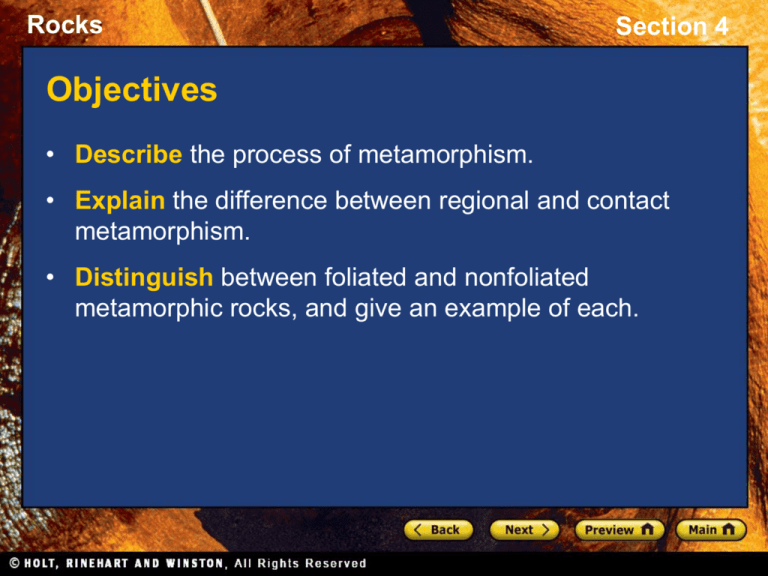Metamorphic
advertisement

Rocks Section 4 Objectives • Describe the process of metamorphism. • Explain the difference between regional and contact metamorphism. • Distinguish between foliated and nonfoliated metamorphic rocks, and give an example of each. Rocks Section 4 Formation of Metamorphic Rocks • Metamorphism the process in which one type of rock changes into metamorphic rock because of chemical processes or changes in temperature and pressure. • During metamorphism, heat, pressure, and hot fluids cause some minerals to change into other minerals. • Minerals may also change in size or shape, or they may separate into parallel bands that give the rock a layered appearance. • Hot fluids may circulate through the rock and change the mineral composition of the rock by dissolving some materials and by adding others. Rocks Section 4 Formation of Metamorphic Rocks • The type of rock that forms because of metamorphism can indicate the conditions under which the original rock changed. • The composition of the rock being metamorphosed, the amount and direction of pressure, and the presence or absence of certain fluids cause different combinations of minerals to form. • Two types of metamorphism occur in Earth’s crust-contact metamorphism and regional metamorphism. Rocks Section 4 Formation of Metamorphic Rocks The diagram below shows how the type of rock that forms during meta-morphism indicates the conditions under which the metamorphism occurred. Rocks Section 4 Formation of Metamorphic Rocks Contact Metamorphism • Contact metamorphism a change in the texture, structure, or chemical composition of a rock due to contact with magma Regional Metamorphism • Regional metamorphism a change in the texture, structure, or chemical composition of a rock due to changes in temperature and pressure over a large area, generally are a result of tectonic forces Rocks Section 4 Formation of Metamorphic Rocks Reading Check How are minerals affected by regional metamorphism? The high pressures and temperatures that result from the movements of tectonic plates may cause chemical changes in the minerals. Rocks Section 4 Classification of Metamorphic Rocks Foliated Rocks • Foliation the metamorphic rock texture in which minerals grains are arranged in planes or bands. • Extreme pressure may cause the mineral crystals in the rock to realign or regrow to form parallel bands. • Foliation also occurs as minerals that have different compositions separate to produce a series of alternating dark and light bands. • Foliated metamorphic rocks include the common rocks slate, schist, and gneiss. Rocks Section 4 Classification of Metamorphic Rocks Nonfoliated Rocks • Nonfoliated the metamorphic rock texture in which minerals grains are not arranged in planes or bands. • Many nonfoliated metamorphic rocks contain grains of only one mineral or contain very small amounts of other minerals. Thus, the rock does not form bands of different minerals. • Other nonfoliated metamorphic rocks contain grains that are round or square. These grains are unlikely to change shape or position when exposed to directed pressure. • Nonfoliated metamorphic rocks include the common rocks marble and quartzite. Rocks Maps in Action Geologic Map of Virginia Section 4









